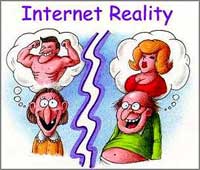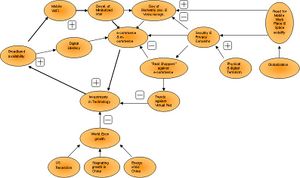Societal Aspects
As ten years have passed and today we need to acknowledge that the Internet did not impact our lives to the degree many observers anticipated ten years ago, we take a good look at what happened and where we stand today in the year 2015. More specifically, what happened to our society and what does it look like today? How has it changed?
In retrospect, it seems that the Internet complemented rather than replaced other types of media, and that it complemented existing patterns of behavioir rather than changing them fundamentally. The dark tragic warnings of how technological capabilities would revolutionise our world had to stand aside and make way for more nuanced opinions of how the Internet as another media per se is merely an added medium to the existing collection and how the use of the Internet adapts to our current patterns of behaviour rather than altering them radically.
One of the paradoxes stated ten years ago was the paradox of a social technology that was expected to reduce social involvement and psychological well-being. Research was done and the trend was documented; however, although this trend can be followed and traced through the past ten years, this has never reached the doom-prophecies of some from the year 2004. Certainly, the Internet is today much more an integrated way of communication that reduces the physical interaction and sets other challenges for presenting our identity digitally through our communication. The trend is expected to continue, increase and should be followed closely by sociologists and psychologists.
Much to the disappointment of the US and the rest of the western world, the threat of global terrorism has not decreased but, if anything, it has only increased. As already noted many years ago, this has brought an urgent need for security, not only on the personal and business level, but as the terror war has moved into the digital world as well, there has been an increase in the demand and need for security and privacy on the internet. e-commerce and mobile commerce has increased significantly over the years with the increased widespread digital literacy, but still some people are stagnating the growth potential due to their fear for the unknown dangers that may occur.
The mobility issue has never the less had a larger impact on the way we conduct our business and personal lives. We continue to have offices and designated workplaces; companies still have factories, sales offices, headquarters etc. and only in exceptional situations, employees are not connected to a certain workplace. However, with increasing globalisation, the workforce has needed to adapt to a more global environment and consequently, mobility is a very high need and priority. Luckily, technology is supporting this through smaller devices and the increase in broadband and WiFi use and availability. We now work in a more mobile way and have multiple workplaces: at the office and at home, and we can continuously connect everywhere and be reached.
On the personal level, dating services have established themselves as a more common and acceptable way of meeting both friends and a 'significant other' and thereby establishing socially connections. The before mentioned fear is further reinforcing this trend as the social interaction online appears to have a safer and non-committing element.

Our purchasing behaviours have changes in the direction that much more is purchased online but it has not taken over the commerce completely as many still prefer to purchase some items online and some items "physically".
Learning and education have become more interactive than previously and many schools and other learning institutions have gone through a larger re-engineering upon which they now offer distance learning and distance education to a much larger extent than seen previously. However, the classical educational institutions still remain and offer the same classical class room session that, however, are simultaneously broadcasted on line for the distance students to follow either in the comfort of their home or on a mobile device.

To keep a healthy work / life balance continues to be one of the larger challenges in many people’s lives. While the Internet has become a fully mobile concept which can be reached and carried everywhere, the societal demand for people to be more efficient, to not let location or situation be a hindrance to ‘doing the job’, to work faster, harder, more and better than ‘the next guy’ increases the difficulty in maintaining a healthy balance between careers, children, and family. Stress related illnesses consequently increase; primarily the Nordic countries continue to demonstrate signs of softer leadership opposing the trend through establishing a more socially sustainable work environment for employees. Never the less, these northern European countries continue to be less competitive in the global environment with higher salaries and taxes, expensive social systems and they are consequently not regarded as role models in the business world.
Back the our front page: Group 5: More of the Same
